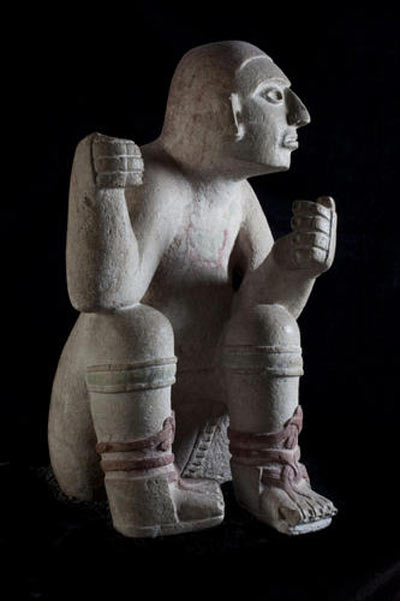
 Sculpture News at SculptSite.com
Sculpture News at SculptSite.com
Mayan Sculpture |
| TheStar.com By Oakland Ross Feature Writer What is roughly lifelike in size, sculpted of limestone, seems awkwardly posed and peers out at the world with a strangely curious demeanour? Actually, no one knows its name. "We know where it was found," says Justin Jennings, curator of New World archaeology at the Royal Ontario Museum. "But we don't know a lot about it." It - or, let's say, he - is known as The Standard Bearer. He was discovered on the Venus Platform at the ruins of Chichen Itza in what is now the southern Mexican state of Yucatán. He dates from the early post-classic period of Mayan civilization, which lasted from AD 900 to 1250. The Standard Bearer is also among the largest and most realistic of the roughly 250 stone or ceramic artifacts that make up an ambitious exhibition now on display at the Royal Ontario Museum, called Maya: Secrets of their Ancient World. Clad in a loincloth, calf ornaments and sandals, The Standard Bearer has assumed an oddly contorted posture. A circular hole in each fist suggests he originally bore a pair of standards - hence his name. They also indicate his profession. "He is a warrior," says Jennings. Armed combat was a central preoccupation of ancient Mayan civilization, but the prosecution of war reached new levels of sophistication in Chichen Itza's heyday. "Now war was an even bigger thing," says Jennings. "War became more professionalized. These guys are full-time warriors." Backed by its military might, Chichen Itza spread its influence through much of the adjoining region, eventually exerting effective control over all the eastern Yucatán. "It was a conquest state," says Jennings. "They had a big trading economy. Things were changing." Art became less stylized than in centuries past and showed technical and cultural influences from as far away as the Valley of Mexico, where the capital of modern-day Mexico now sprawls. Social values were evolving, as well. In the late-classic period, from AD 600 to 900, artists tended to celebrate the cult of sacred rule above all else, but the heroes at Chichen Itza were soldiers, not kings. On his chest, The Standard Bearer wears a pendant depicting ik' - the symbol of the wind. A series of grooves on his skull represent either hair or a helmet. He seems ready at any moment to climb to his sandal-clad feet and commence another rugged march into another bloody battle. That was the tenor of the times. As for the fate of the Maya as a whole, their fortunes have continued to ebb and flow over the centuries that have ground past since those distant post-classic days. They were undoubtedly a formidable civilization in ancient times, a people of mystery and grandeur, but the Maya are modernists, too. "There are 10 million Mayans today," says Jennings. "They never went away." |
 A great story and read by Oakland Ross about an unknown and untitled Mayan sculpture. Isn't the gaze intriguing! |
 Mayan Sculpture (unknown) |
| Mayan artifact of the Standard Bearer at an exhibition at ROM JORGE VERTIZ/CONACULTA-INAH |
More Sculpture News ....
Submit your SCULPTURE NEWS.
It's easy, just send us an e-mail
(click on Submit News in the left menu) with your pertinent information along with images, we'll take care of the rest. Sculpture makes our world a much better place in so many ways!
SculptSite.com, along with Sculptors and their creative genius all helping to bring the beauty and message of Sculpture to a hurried world.

